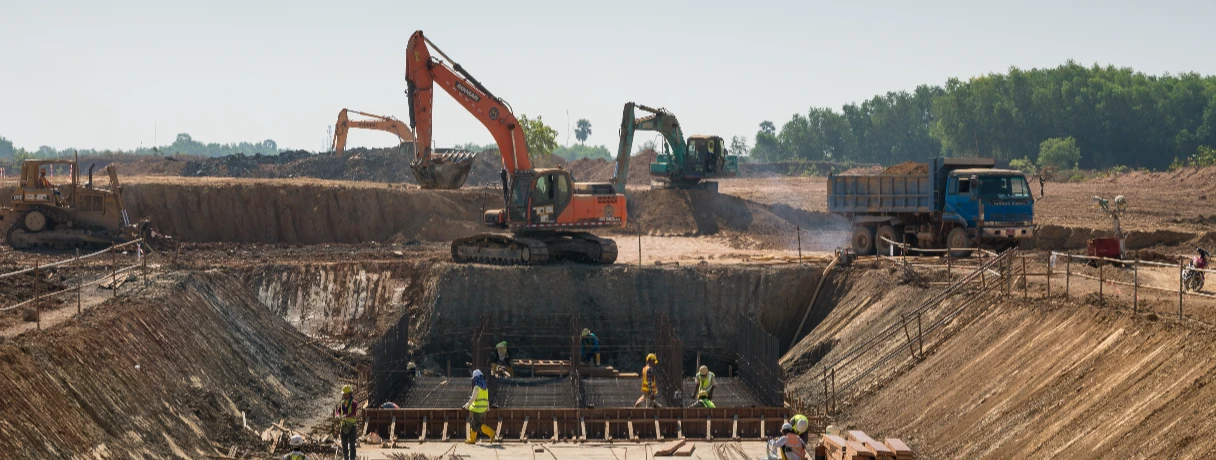Running an earthwork project smoothly starts long before the first shovel hits the ground. A successful project requires detailed planning and accurate calculations, especially when it comes to determining the volumes of material to be moved. Whether you’re cutting through tough soil to lower the land or filling areas to create the perfect elevation, earthwork takeoffs are the backbone of every project.
But let’s face it—navigating all the complexities of earthwork takeoffs can be tricky. There are so many variables—site conditions, soil behavior, material volumes—that even a small mistake can lead to big problems down the line. Luckily, with the right process and tools, you can get accurate earthwork takeoffs every time. Let’s dig into the essentials so you can stay ahead of the competitors on your next project.
What is an Earthwork Takeoff?
Earthwork takeoff is the process of calculating the volume of soil and materials that need to be moved to prepare a site for construction. It’s a balance between cutting (removing material to lower areas) and filling (adding material to raise the site). Without these calculations, you can’t get the land ready for foundations, roads, or anything else. In simple terms: if your takeoffs are wrong, the entire project can fall apart before it even begins.
These calculations are crucial for several reasons:
- Budgeting: Earthwork takeoffs directly impact your costs. When you know exactly how much material to move, you can estimate costs accurately and avoid budget overruns.
- Planning: Understanding the earthwork requirements allows for efficient scheduling of labor, materials, and equipment.
- Risk Mitigation: Getting the quantities right helps prevent issues like soil instability, drainage problems, or costly delays.
Why Are Accurate Earthwork Takeoffs So Important?
Accurate takeoffs are crucial for the success of any construction project. By getting the numbers right from the start, you set the stage for a smooth project, avoid costly mistakes, and keep everything on track. Here’s why accuracy matters:
1. Accurate Budgeting
Earthwork is often one of the first phases of construction. If your takeoffs are off, your budget will be too. But when you know exactly how much material needs to be moved, you can price the project more accurately, avoid surprises, and make sure you stay on target financially.
2. Efficient Resource Allocation
When you have precise takeoffs, it’s easier to plan what resources you'll need. Think about it—if you know ahead of time exactly how much labor, machinery, and materials will be required, you’ll avoid material shortages or having extra supplies lying around.
3. Site Preparation
Imagine laying the foundation only to find that the site wasn’t properly leveled—now you’re dealing with uneven floors or water pooling where it shouldn’t.
Before you can lay the foundation, the site needs to be leveled and graded. Earthwork takeoffs make sure the land is stable and ready to bear the weight of the building, preventing future problems like uneven foundations or water drainage issues.
4. Environmental Considerations
No one likes unnecessary excavation. Accurate takeoffs help you avoid over-digging and reduce waste, keeping the site as close to its natural state as possible. Plus, you’ll be more prepared to manage erosion control, protecting the environment during construction.
Key Components of an Earthwork Takeoff
To perform a comprehensive earthwork takeoff, you need to account for several key components:
1.Material Quantities Involved in Earthwork
- Soil and Topsoil: Calculate how much soil needs to be removed (cut) or added (fill). Keep in mind, you’ll often store the topsoil for use later, like landscaping or backfilling.
- Gravel and Aggregate: These materials are commonly used for stabilizing subgrades and facilitating drainage, particularly in road construction or under foundations.
- Backfill Materials: This includes sand, stone, and other materials used to fill voids after excavation and to provide stability around foundations and trenches.
- Erosion Control Materials: To prevent soil erosion, especially on sloped sites, materials like silt fences and geotextiles are factored into the takeoff.
2. Cut and Fill Operations
The cut and fill operation is one of the most important parts of earthwork takeoff. It involves calculating how much soil needs to be removed from certain areas (cut) and how much needs to be added elsewhere (fill) to achieve the desired grade. The goal is to balance the amount of cut and fill to minimize material transport costs.
3. Subgrade Preparation
Preparing the subgrade involves compacting the soil to provide a stable base for the structure. The materials required for subgrade preparation are included in the takeoff to ensure the site is ready for construction.
4. Excavation and Grading
Earthwork takeoffs account for the amount of excavation needed for foundations, utility trenches, and other underground features. Grading is also essential to ensure proper water drainage and to create a stable base for the foundation.
5. Drainage and Erosion Control
Proper site drainage is critical to preventing water damage and erosion. Drainage pipes, ditches, and erosion control materials must be included in the takeoff to ensure the site remains stable during and after construction.
How to Takeoff Earthwork Quantities?
Step 1: Gathering Site Data
Before you even start calculating, review site plans, topographical surveys, and architectural drawings. Do the contours make sense? Are there hidden challenges like elevation changes or unexpected slopes? If you miss something like site’s dimensions or elevations at this stage, it’ll cost you down the line.
Step 2: Calculating Cut and Fill Volumes
Once you’ve got the site data, the next critical step is calculating the cut and fill volumes. This is where you figure out how much material needs to be moved, either by cutting or filling, to bring the site to the right elevation. Using the site’s topographical data, the areas that require cuts or fills are identified, and the volumes are calculated. The goal is to balance these quantities as closely as possible to reduce costs and save time.
Step 3: Incorporating Adjustments for Material Shrinkage and Expansion
Soil isn’t static—it expands when removed from its natural state and shrinks when compacted into place.
If you don’t account for this, you’ll end up with inaccurate estimates, which can lead to material shortages or oversupply. For example, excavated material may expand by 20%, meaning the initial cut volume may need to be adjusted. Similarly, fill material may shrink by 10% once compacted, so more material may be needed to meet the required grade.
Step 4: Using Technology for Earthwork Takeoffs
Advanced AI-powered takeoff tools like Beam AI, can automate complex calculations and drastically reduce the time spent on taking off earthwork quantities. The estimators can simply input the site’s data into the takeoff tools and it automatically calculates material quantities, identifies areas requiring cuts and fills, and generates detailed reports for project planning. The adoption of these tools not only saves time but also allows estimators to focus on strategic tasks, such as optimizing costs and value engineering.
Leveraging Technology in Earthwork Takeoffs
Traditionally, earthwork takeoffs were done manually—lots of printed plans, rulers, and calculators. It worked, but it took forever and was prone to human error. Today, most contractors use takeoff software, which speeds things up and improves accuracy, but even then, manual input is still required.
That’s where AI-powered tools like Beam AI come in. These tools completely automate the process, from analyzing plans to detecting contours and material needs. Instead of spending hours clicking through software, you can let AI handle it while you focus on refining your estimates, optimizing costs, and keeping the project on track.
The shift from traditional methods to modern takeoff software has brought about increased accuracy and efficiency. Below is a comparison between Manual Takeoff Software and AI-Powered Takeoffs, like Beam AI, which highlights key differences that have reshaped the industry.

Wrapping It Up
Mastering construction takeoffs is not as simple as it sounds; it takes practical experience and a deep understanding of the process. Earthwork takeoffs are essential for the success of any construction project, laying the groundwork for accurate budgeting, resource planning, and site preparation. With AI-powered tools like Beam AI, you can streamline your takeoff process, reduce errors, and focus on delivering high-quality work faster.
To learn more about how Beam AI can enhance your earthwork takeoff process and improve project outcomes, book a demo today.










.png)



.webp)

